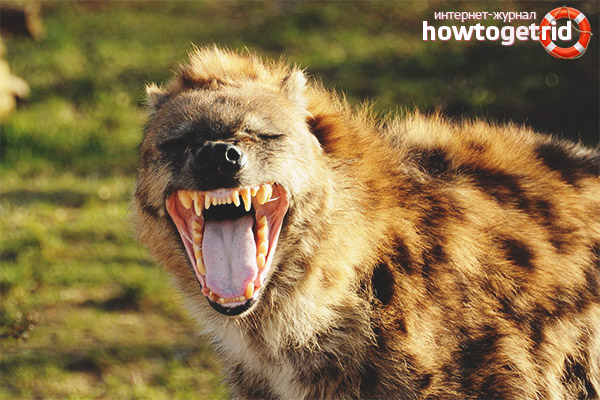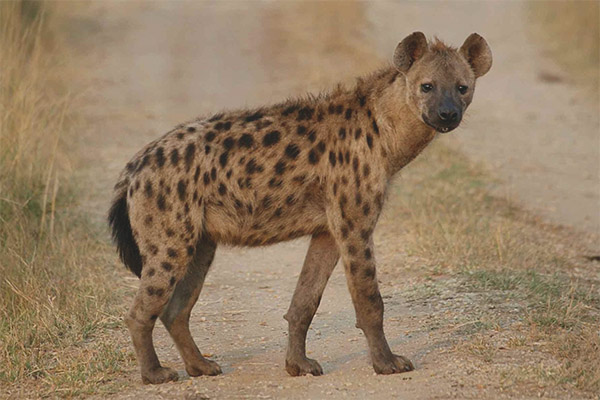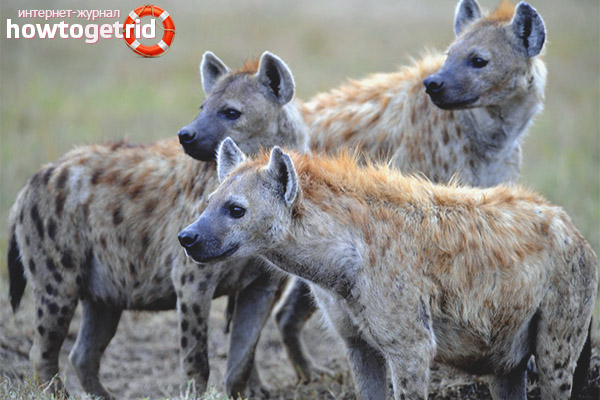The content of the article
Hyenas - one of the few animals that cause people a sense of dislike and disgust. Their appearance, as well as the behavior during the hunt, does not cause any positive feelings or emotions. For a long time they were considered mysterious and almost unexplored creatures, so people let the most ridiculous rumors about them, which (and this is strange) were believed even by people with a sound mind.
What kind of animals are these?
Hyenas are mammals from the order of predators, belong to the feline sub-order. Scientists once attributed them to canine relatives, but some time ago they concluded that this classification is fundamentally wrong, and decided to attribute them to felines.
In total, this family has 4 species: striped hyena, brown, spotted and earth wolf.The difference between them is insignificant - the difference is only in appearance and size, so the story will follow the example of a spotted hyena.
Appearance and description
The appearance of a hyena resembles a mongrel of an intimidating look. In its family of spotted hyenas, the largest size. Their jaws are so strong that they can gnaw and crush the bone of absolutely any animal, even an elephant.
Hyenas are the only animals where not the males are larger, but the females.
Body - from 125 to 165 centimeters long, height at withers - from 75 to 91 centimeters. Weight - from 60 to 82 kilograms. The paws are short and crooked, and the front ones are much longer than the hind ones, therefore, at the sight of an animal it seems as if it constantly crouches while walking.
On the paws of 4 fingers with long blunt claws, with which they dig up the body from the ground and tear holes. The head is big, the muzzle is a little blunt. The body is covered with short gray-sand wool, over the entire surface of which brown spots are scattered.
The tail is long - from 25 to 34 centimeters. Looking at him, one can understand what the animal’s social status is in the pack: raised upwards means the leader of the animal, down to the paws is an outsider.Each hyena smells its own smell - a person considers it disgusting and unpleasant, for an animal it serves as a method of communication and communication.
Habitats
The main habitat is savanna, in which there is an opportunity to catch an animal as food. They only avoid deserts and do not climb into the dense forests.
Vote
Hyenas have a rather diverse language, communication takes place through sounds - first of all, they laugh. Although there is not only laughter, there are also howls, growls and loud cries. In a similar manner, animals establish a feeding pattern: the dominant female notifies those around that it has ceased to eat, and now another individual can eat up the hierarchical ladder. This method allows hyenas prone to squabbling and fighting to avoid any kind of conflict.
And here the dominant role of females is manifested: to the exclamation issued by the male, there will be no immediate reaction - he will have to repeat the shout several times to be heard. The sounds made by the female, members of the clan hear immediately and react instantly.
Lifestyle

Spotted hyenas are herd animals. They form a clan, in which there can be from a dozen to a hundred individuals, for the most part - women. Among the animals reigns strict matriarchy - the female, even occupying a low level in the hierarchy, is in a position above any male. Apparently, this is due to the fact that there is a lot of testosterone in the blood of females, which gives them greater aggressiveness and helps to increase physical strength. The head becomes the dominant female, managed to stand out by force and size. Other members submissively obey her.
The dominant female along with the offspring are the first to get prey and have the full right to choose the best places for rest. Female children inherit the social rights of the mother. And the males are growing up and moving to another clan.
Each group has its own territory assigned to it. Special marks are used as borders - visual (for example, the ground clawed with claws) and smell (the smell coming from the sticky secret, which is designed specifically to mark the territory). As a rule, these duties are also performed by females.
Reproduction of offspring
For a long time it was believed that this type of hyenas are hermaphroditic, and scientists had the confidence that they enter into homosexual contact and childbirth occur through a unique sexual system.
In fact, that males, that females who are born, remain the same. And it is difficult to distinguish them due to the fact that the female genitals are the same as the penis in males - they are very similar. The reason for the similarity is that females have a very long clitoris, reaching 15 centimeters in length (and the larger it is, the higher the position in the female group), and with the help of the labia, a fold resembling the scrotum is formed.
That is, it turns out that the female is completely devoid of the vagina and the process of mating and childbirth occurs through the clitoris.This process is complex, it is painful, and the female gives birth for hours (especially for the first time). Because of this, part of the puppies die from lack of air, and the female has many chances to die.
The hyenas do not have a strictly defined time for mating games, they can mate at any time of the year. As a rule, in Central Africa, the season comes during the rains, and closer to the north is in the spring.
The female partner always takes a male from another clan so that there are no crossings between relatives.
Males with the help of smell know that the female is ready to mate. They carefully sniff under the tail of the female, or catch the smell from the place where she lay. Having learned that the female expresses readiness, the male comes up to her and tilts her head, thereby showing that she fully obeys her. Once consent is obtained, the pairing process takes place.
The onset of pregnancy lasts approximately 100 days.
Before the birth, the expectant mother in advance looks for a cave or tears a hole and gives birth there. Usually there are 1-3 babies, but maybe more. They are born already covered with wool, able to see with formed teeth.The weight of children is approximately 1.1 - 1.5 kilograms.
Mother feeds milk for a long time - up to one and a half years, and it is so rich in essential elements and so nourishing that babies can eat nothing else for almost a week. Already in the fourth month of life the weight of small hyenas reaches 15 kilograms.
If there are two females among the cubs, then from the very first minutes they start to compete with each other - one rushes to the other and tries to tear off the rival. Often, these attempts end successfully - about 25 percent of the children die, not having time to really know the joy of life. But the survivors get more milk and attention to the mother.
After some time, the passion to kill their own kind passes, and the survivors learn to live side by side in the same flock. Grown-up hyenas enter adult life in the third year.
Nutrition

No wonder that hyenas are famous as carrion and scavengers. Their main food is the bodies of dead animals. They are absolutely not distinguished by fastidiousness, so any meat caught in the way (it doesn’t matter - a live zebra or a rotten elephant carcass) will be eaten.But often they hunt themselves, medium-sized mammals such as antelopes, gazelles and zebras are prey. Thanks to excellent hearing and good vision, it is easy for them to track down the victim.
With pleasure they eat birds, snakes, lizards, eggs left unattended, do not disdain even the corpses of dead representatives of their own species.
The hyena catches the animal with its teeth tearing the blood vessels, and then from the living begin to tear pieces of meat. It is cruel, but in this way the animal dies faster than if it were strangled. The prey is eaten completely, even licked the grass and the ground on which the food lay.
They attack not very large animals one by one, and larger ones are hunted by a group. A herd of antelopes or zebras surround the crescent and drive him. It is only for someone from the ungulates to keep up with the pack - immediately turns into a victim.
Fact! Flocks of hyenas are able to drive even the beast larger than they are - a buffalo or a little elephant.
Thanks to the device of the digestive system, animals are able to digest everything, down to the bones. Very sour gastric juice copes with this. Food is digested only during the day.
The enemies
Benefit
Although many negative “labels” have been hung on hyenas, but from them the territory of savannas receives a very great benefit: a large number of dead animals do not accumulate on earth, which means that various diseases dangerous to others do not arise and do not spread.
Interesting Facts
- African (and not only) peoples have legends and beliefs connected with hyenas. For example, African locals saw how persistently these creations were breaking open graves and believed that hyenas were werewolves possessed by evil spirits.
- And the Arabs, killing hyenas, tore a hole and tried to bury their heads as deep as possible, otherwise the animal will return and make a terrible revenge.
- One of the philosophers, living in ancient Greece, believed that hyenas are hermaphroditic and can change gender. Another believed - they imitate human voices to lure people into the street and tear them into small pieces.
- Only the spotted hyena has such laughter, other kinds of similar sounds do not emit. They roar, scream, grumble and howl in a hoarse, rough voice.
- Hyenas seem clumsy, but develop a decent speed - more than 60 kilometers per hour.
- About ten percent of mothers die during childbirth.
- Although hyenas are called scavengers, they get up to 90 percent of the food by hunting on their own.
- In nature, the hyena lives a little more than 20 years. And in conditions of captivity, the lifespan is almost 2 times longer - it can reach up to 40 years.
Spotted hyenas do not belong to endangered species, but they are getting smaller. Therefore, this species is listed in the Red Book.
Video: Spotted hyena (Crocuta crocuta)












To send